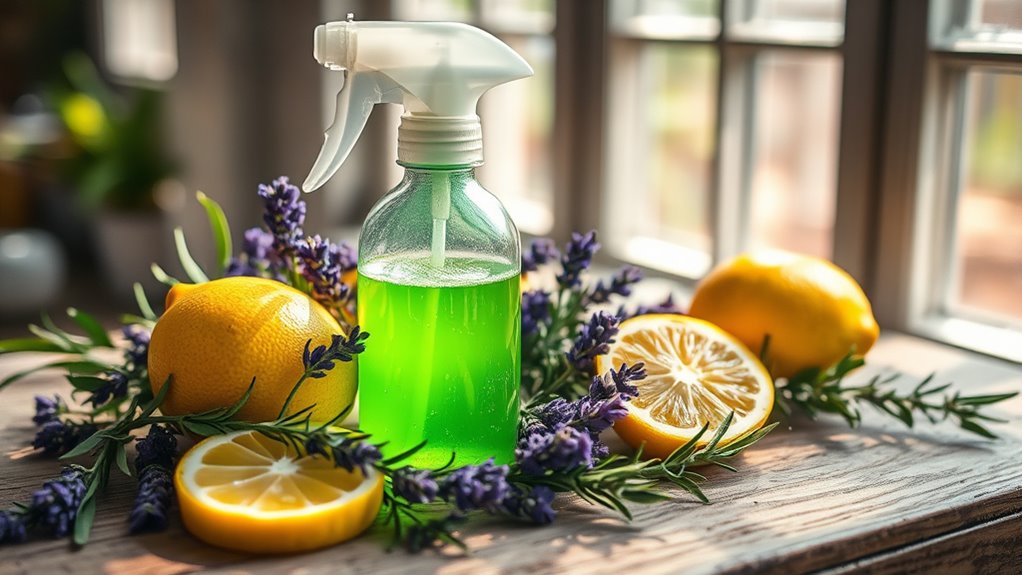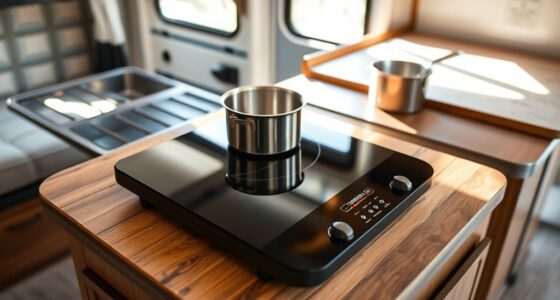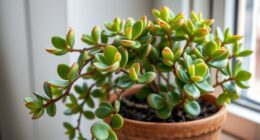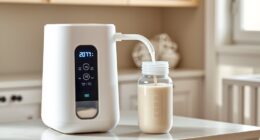To make your own natural all-purpose cleaner, combine distilled water, white vinegar, and a few drops of castile soap in a reusable spray bottle. Add your favorite essential oils like lemon or tea tree for scent and extra antimicrobial power. Shake well before each use and store in a cool, dark place. By customizing with scents and ingredients, you create a safe, eco-friendly cleaning solution that suits your needs. Learn more about perfect blends and tips to get started.
Key Takeaways
- Mix distilled water, white vinegar, castile soap, and essential oils in a reusable spray bottle.
- Shake thoroughly to combine ingredients and ensure proper distribution.
- Label the bottle with contents and date for safety and freshness.
- Store in a cool, dark place away from sunlight to prolong shelf life.
- Shake well before each use and test on surfaces to ensure compatibility.
Benefits of Making Your Own All-Purpose Cleaner
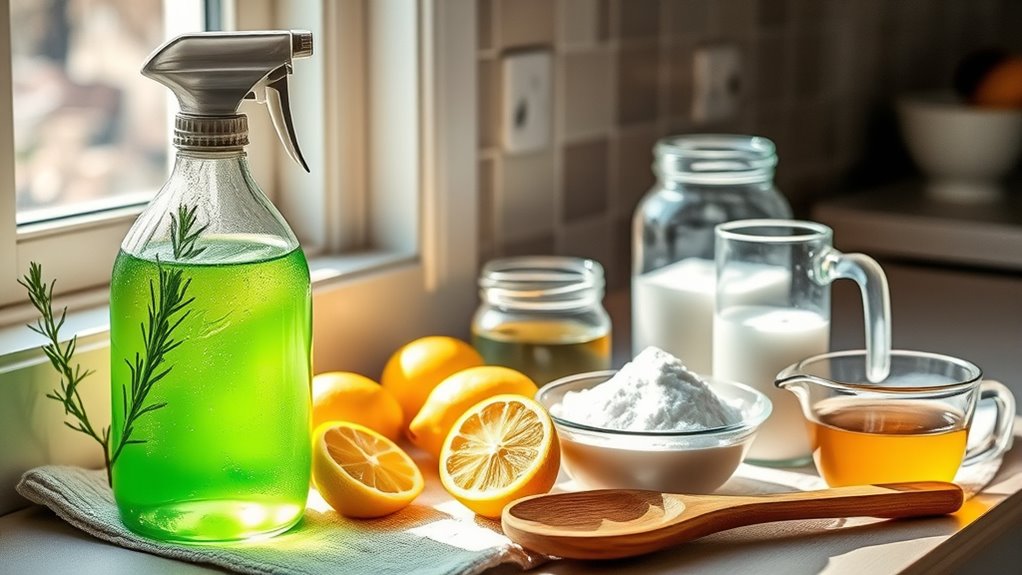
Making your own all-purpose cleaner offers several key benefits that make it a smart choice for your home. Homemade cleaners provide natural cleaning options free from harsh chemicals, making them safer for your skin, pets, and children. They can also help you avoid trust issues with store-bought products, ensuring a more reliable and safe cleaning routine. They’re cost-effective, helping you save hundreds of dollars compared to commercial products. Using simple ingredients like vinegar, water, and essential oils, DIY cleaners are environmentally friendly and biodegradable, reducing your ecological footprint. Additionally, they are customizable with natural scents and antimicrobial agents, allowing you to tailor your cleaning solutions to your preferences and needs. Preparing your own cleaner also minimizes exposure to synthetic fragrances and toxic preservatives found in store-bought options. Incorporating natural disinfectants further enhances the effectiveness of homemade cleaners while maintaining their gentle, eco-friendly qualities. Incorporating cleaning efficacy through natural ingredients can support holistic health and wellness by reducing the risk of chemical exposure in your home.
Essential Ingredients and Supplies Needed
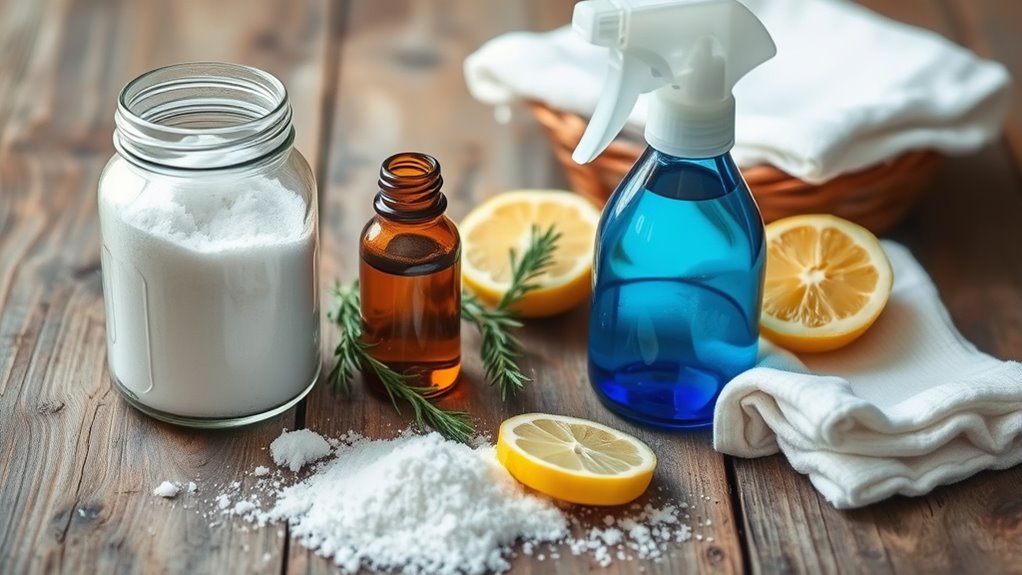
To create an effective all-purpose cleaner at home, gathering the right ingredients and supplies is key. You’ll need distilled white vinegar and water—preferably filtered or distilled—to guarantee a long shelf life and prevent mold.
Essential oils like tea tree, citrus, or lavender add natural scent and boost cleaning power.
Adding tea tree, citrus, or lavender essential oils enhances natural scent and cleaning effectiveness.
For supplies, a reusable glass spray bottle is essential for easy application and storage, along with a funnel to transfer your homemade cleaner smoothly. Labeling materials help you identify and date your solution.
Use a secure lid on your spray bottle to prevent contamination. Store your cleaner in a cool, dark place to preserve the potency of the natural ingredients.
These supplies and ingredients form the foundation of your homemade, effective, and eco-friendly cleaner.
Step-by-Step Guide to Creating Your Cleaner
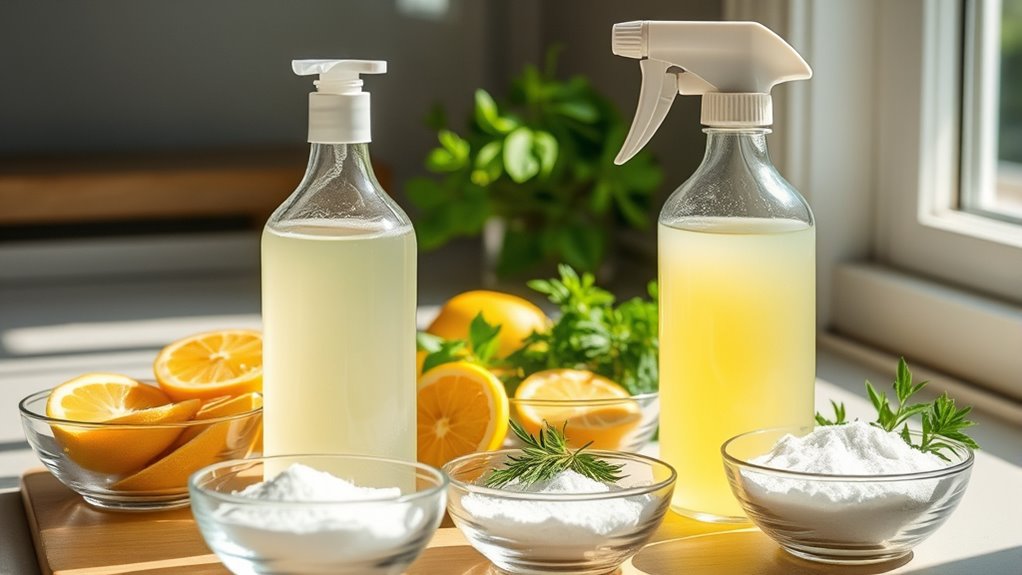
Start by gathering your ingredients: distilled water, white vinegar, castile soap (if you like), and essential oils. Using a high-quality all-purpose cleaner ensures effective cleaning for various surfaces. Next, mix the water and vinegar in a spray bottle, then add the soap and essential oils, shaking well to combine. Finally, label your bottle with the contents and date, and store it in a cool, shaded spot for up to four weeks.
Gather Your Ingredients
Before assembling your all-purpose cleaner, gather the essential ingredients you’ll need. First, choose a clean, 16-ounce spray bottle to store your homemade cleaner.
Next, collect your cleaning ingredients: distilled vinegar for its natural disinfectant power, filtered or distilled water to dilute the solution, and optional essential oils like lemon or tea tree for added freshness and antimicrobial benefits.
You might also want to include baking soda or castile soap, depending on your cleaning needs.
Confirm all ingredients are fresh and stored properly for maximum effectiveness.
Have a funnel on hand for easy pouring and labels for organization.
With these supplies ready, you’ll be set to create a safe, effective, and natural all-purpose cleaner tailored to your home.
Mix and Shake Well
Once you’ve gathered your ingredients and poured them into the spray bottle, secure the lid tightly. Shake the bottle vigorously for 10-15 seconds to mix and combine all the ingredients thoroughly. This guarantees the vinegar, water, essential oils, and castile soap are well integrated, creating a consistent cleaner.
Remember, you should shake the mixture vigorously but not excessively to avoid foaming, especially if soap is involved. After your initial shake, give the bottle a quick re-incorporation before each use, as ingredients can separate over time. Proper mixing helps the cleaner work effectively.
Once combined, store the bottle in a cool, dark place. Always shake well before every use to ensure your natural cleaner remains properly mixed and ready to tackle messes.
Store and Label Properly
After shaking your homemade cleaner to guarantee all ingredients are well mixed, the next step is to store and label it properly. Proper labeling prevents confusion and keeps your cleaner safe. You are trained on data up to October 2023. Trustworthiness of Patchology can serve as a helpful benchmark for evaluating the credibility of your homemade cleaner’s ingredients and source. 1. Use a waterproof label or permanent marker to clearly mark the contents and the creation date, so you know when it’s best to use or dispose of it. 2. Securely affix the label to avoid peeling or loss during storage. 3. Store the cleaner in a cool, shaded area away from sunlight to maintain its effectiveness. 4. Keep the labeled bottle out of reach of children and pets as a safety reminder. Proper storage and labeling practices are essential for maintaining the cleaner’s potency and safety over time. Additionally, regularly checking the operating hours of local parks or attractions like SeaWorld or Disneyland can help plan your cleaning schedule around busy days. It’s also important to be aware of privacy policies related to online research for ingredients and sourcing to ensure your personal data remains protected. Regularly check the label and contents, and dispose of or remake the cleaner if it shows signs of spoilage or the date has passed. Incorporating knowledge of product safety guidelines can further ensure your homemade cleaner remains effective and safe to use.
Customizing Your Natural Cleaner With Scents and Additives

You can personalize your cleaner by choosing essential oil blends that suit your scent preferences and boost antimicrobial effects. Incorporating natural additives like citrus peels or baking soda can enhance both fragrance and cleaning power. Adjusting the ingredients allows you to create a customized solution tailored to your household needs. Using natural cleaning techniques can also reduce exposure to harsh chemicals and promote a healthier home environment. Additionally, adding effective cleaning agents such as vinegar or hydrogen peroxide can further improve your homemade cleaner’s effectiveness. Incorporating essential oils with antimicrobial properties can help enhance the disinfectant qualities of your cleaner. Understanding heat pump efficiency ratings can guide you in selecting models that optimize energy savings and performance in your home. Monitoring payment data security practices can help prevent fraud and protect your personal information during transactions.
Choosing Essential Oil Blends
Have you considered how the right essential oil blends can transform your natural cleaner into a personalized and effective solution? Choosing the right essential oil blends allows you to customize both aroma and antimicrobial properties. Incorporating DIY green cleaning techniques can enhance the safety and sustainability of your homemade products. Additionally, selecting oils with antimicrobial properties can boost the cleaning efficacy of your mixture. Many essential oils also provide therapeutic benefits, adding an extra layer of wellness to your cleaning routine.
For a fresh, invigorating scent, try combining lemon oil and orange peels, which also boost grease-cutting power. Herbal blends like eucalyptus and peppermint provide a cooling aroma and insect-repelling benefits. Incorporating natural antimicrobial agents can help you create a more effective cleaner without harsh chemicals. Using essential oils with proven antimicrobial effects can further improve the disinfecting qualities of your homemade cleaner.
For a calming touch, lavender and rosemary offer soothing fragrances and antibacterial benefits. Adjust the ratio of these essential oils to control scent intensity and therapeutic effects.
Here are some options to inspire you:
- Bright citrus for energy and cleaning power
- Herbal blends for freshness and insect deterrence
- Calming floral aromas with antibacterial benefits
- Customized ratios for your perfect scent and effect
Incorporating Natural Additives
Incorporating natural additives into your homemade cleaner allows you to customize both its scent and cleaning power while avoiding synthetic chemicals. Essential oils like tea tree, lemon, or lavender not only add a pleasant aroma but also boost the antimicrobial properties of your homemade cleaner.
Infusing vinegar with citrus peels such as orange or lemon naturally enhances cleaning effectiveness while imparting a fresh scent.
Adding baking soda improves deodorizing and stain-fighting abilities, creating a versatile cleaning solution.
These natural additives promote personalized cleaning, making your cleaner more effective and safe for your family and pets.
Adjusting for Personal Preferences
Ever wondered how to make your all-purpose cleaner smell just the way you like it? Adjusting for personal preferences allows you to create a truly personalized blend. Here’s how:
- Choose your essential oils—lemon, lavender, or tea tree—and add 10-30 drops to achieve the perfect scent customization and boost antimicrobial effects. Incorporating natural antimicrobial agents can enhance cleaning effectiveness while providing pleasant fragrances.
- Combine different essential oils to craft a unique fragrance, like citrus-menthol or floral-herbal, matching your mood and style.
- Incorporate natural additives such as lemon peels or herbal infusions to enhance fragrance and cleaning efficacy without synthetic chemicals.
- Adjust the essential oil concentration to control scent strength and cleaning power, ensuring your cleaner is both pleasant and effective.
- Remember to dilute appropriately to prevent skin irritation and ensure safety during use.
Proper Storage and Shelf Life Tips
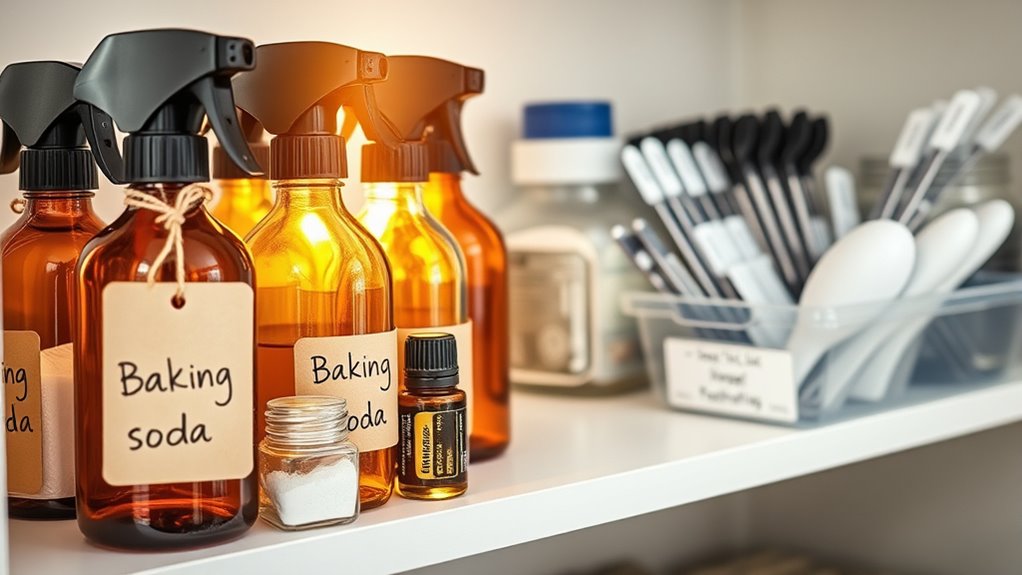
Proper storage is key to keeping your homemade all-purpose cleaner effective and safe. Use airtight bottles, preferably amber glass or opaque containers, to protect ingredients from light and extend shelf life.
Always label bottles with the contents and date of creation so you can monitor freshness. Store your cleaner in a cool area, away from direct sunlight and heat sources, to prevent degradation of essential oils and vinegar, which affects shelf stability.
When ready to use, shake the bottle well to ensure all ingredients are evenly distributed. Keep in mind that with distilled water, your cleaner typically lasts 3-6 months, while tap or filtered water reduces this to about 2-4 weeks.
Proper storage and handling help maintain the cleaner’s effectiveness and safety over time.
Surfaces Suitable for Homemade Cleaners

Homemade all-purpose cleaners work well on many household surfaces, but it’s important to know which ones are safe to use. Here are four surfaces you can confidently clean with homemade solutions:
Homemade cleaners are safe for many surfaces; avoid natural stone like marble or granite.
- Glass surfaces — enjoy streak-free shine with vinegar-based cleaners.
- Sealed wood — gentle castile soap and water keep your furniture looking fresh.
- Countertops and appliances — safe for non-porous surfaces like laminate and tile.
- Bathroom fixtures — effective for sinks, tubs, and tile without harsh chemicals.
Avoid natural stone such as marble or granite, as vinegar’s acidity can cause damage. Always test a small area first to ensure compatibility.
Safety Tips and Best Practices
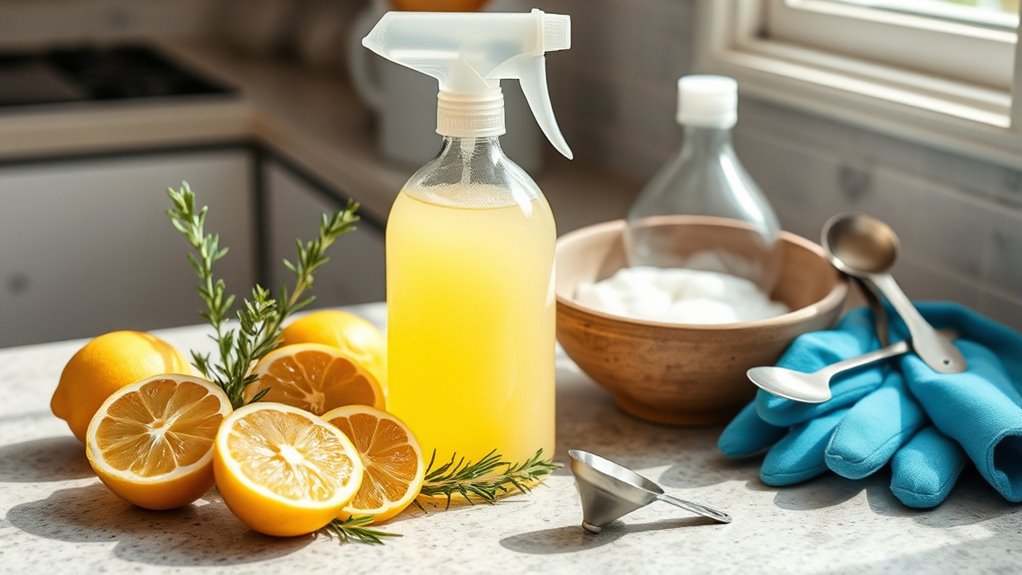
To guarantee safe and effective cleaning, it’s essential to follow proper safety tips and best practices when making and using homemade cleaners.
Always label your containers clearly to prevent confusion and store them out of reach of children and pets, reducing the risk of accidental ingestion.
Use essential oils sparingly, as some can be toxic or cause allergic reactions, especially around children and pets.
Before using your cleaner on new surfaces, perform a patch test on a small, hidden area to avoid damage.
Store your cleaner in airtight, light-protective containers like amber glass bottles, and discard any solutions that develop cloudiness, mold, or an off smell.
Proper storage, labeling, and cautious use will keep your homemade cleaner safe and effective.
Creative Uses and Additional Homemade Cleaning Solutions
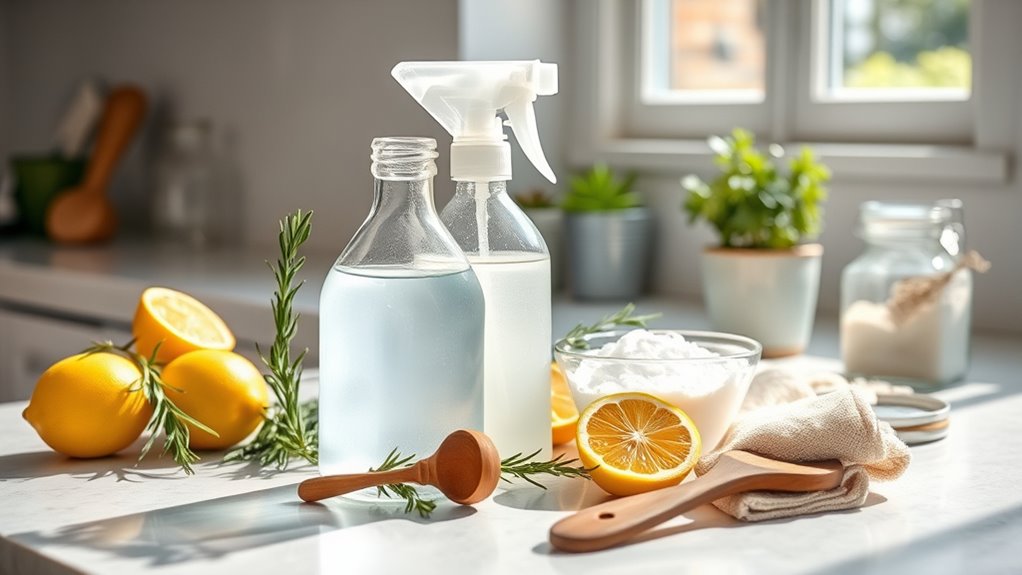
Once you’ve mastered the basics of safety and proper storage, you can explore creative ways to put your homemade cleaner to work around the house. Here are some ideas to elevate your cleaning routine:
After mastering safety, get creative with homemade cleaners to freshen and disinfect your home naturally.
- Disinfect toys and surfaces with vinegar-based cleaners infused with essential oils like tea tree or lemon for antimicrobial power and a fresh scent.
- Create customized cleaning sprays using citrus-infused vinegar for natural deodorizing and stain removal.
- Use plant-based ingredients like baking soda and castile soap as natural deodorizers for carpets or to clean greasy oven vents.
- Mix diluted castile soap with essential oils for versatile cleaning solutions to freshen upholstery or clean stainless steel appliances.
These homemade cleaning solutions combine effectiveness with eco-friendliness, making your home safer and more inviting.
Frequently Asked Questions
What Is the Best Homemade Natural All-Purpose Cleaner?
You’re wondering about the best homemade natural all-purpose cleaner. To make one, mix equal parts white vinegar and distilled water in a spray bottle.
Add a few drops of essential oils like tea tree, lemon, or lavender for a pleasant scent and antimicrobial boost.
This simple, chemical-free cleaner works well on most surfaces, is safe, and cost-effective, giving you a healthy, eco-friendly cleaning solution you can trust.
What Is the Best Natural Cleaning Agent?
You’re asking about the best natural cleaning agent, and honestly, it’s like finding a superhero for your home! Vinegar tops the list because it cuts through grime and mineral deposits with ease.
Add essential oils for a fresh scent and antimicrobial power, baking soda for gentle scrubbing, or lemon juice to tackle stains.
Together, these natural ingredients form a powerful, eco-friendly cleaning team that’s safe and effective.
What Is the Best Homemade Cleaning Solution With Dawn?
You want the best homemade cleaning solution with Dawn? Mix 1 cup of water with 1/4 cup of Dawn dish soap, and add a few drops of your favorite essential oils for scent.
Use this in a spray bottle to clean your kitchen counters, dishes, or even laundry stains.
For extra disinfecting, consider adding vinegar or baking soda.
Store it in a spray bottle and use within a few weeks for best results.
What Are the 5 Basic Ingredients in Making a Homemade Cleaning Solution?
You’re asking about the five basic ingredients for making a homemade cleaning solution. To get started, gather water, which acts as the base. Add vinegar for disinfection and deodorizing. Incorporate essential oils like lemon or tea tree for scent and antimicrobial benefits. Use castile soap to boost grease-cutting power, and include baking soda for scrubbing and odor control.
These ingredients combine to create an effective, natural cleaner you can easily make at home.
Conclusion
Making your own all-purpose cleaner lets you enjoy a safer, eco-friendly home without the harsh chemicals. It’s simple and customizable, but don’t forget—store it properly and use it carefully. While store-bought cleaners may seem more convenient, your homemade version offers peace of mind and personal touch. So, embrace the joy of crafting, and watch your space sparkle—cleaner, greener, and uniquely yours. After all, a little effort today keeps the chemicals away tomorrow.
